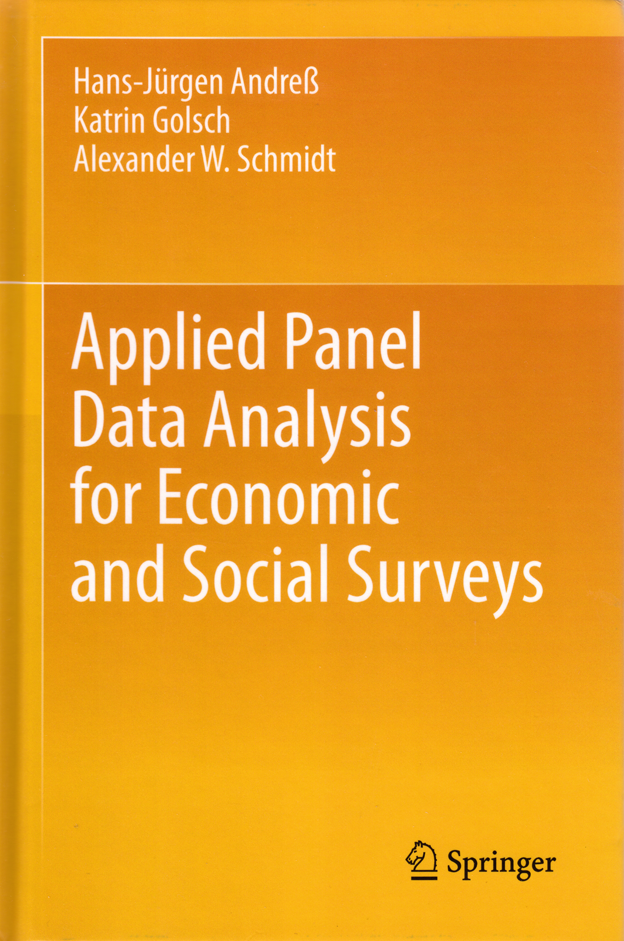

20% off Stata Gift Shop purchases through 12 December
Applied Panel Data Analysis for Economic and Social Surveys |
||||||||||||||||||||||||||||||||||||
 Click to enlarge See the back cover |

As an Amazon Associate, StataCorp earns a small referral credit from
qualifying purchases made from affiliate links on our site.
eBook not available for this title
eBook not available for this title |
|
||||||||||||||||||||||||||||||||||
Comment from the Stata technical groupApplied Panel Data Analysis for Economic and Social Surveys, by Hans-Jürgen Andreß, Katrin Golsch, and Alexander W. Schmidt, provides a rigorous yet intuitive discussion of panel-data methods as they are used in the social sciences. Because the book does not make use of matrix algebra or advanced econometric methods, it will appeal to masters-level students and practitioners as well as doctoral students and researchers. The book covers all commonly used estimation methods, including fixed- and random-effects estimators, first-difference estimators, and maximum likelihood estimators. Separate chapters consider continuous and categorical dependent variables. In contrast to many panel-data texts, Applied Panel Data Analysis for Economic and Social Surveys also considers discrete-time event-study (hazard) models and their relationship to other panel-data models. All the datasets used in the book are available in Stata format as well as Stata do-files to replicate all the examples in the text. |
||||||||||||||||||||||||||||||||||||
Table of contentsView table of contents >> 1 Introduction
1.1 Benefits and Challenges of the Panel Design
1.1.1 Benefits
1.2 Outline of the Book1.1.2 Challenges 1.3 Audience and Prerequisites 2 Managing Panel Data
2.1 The Nature of Panel Data
2.2 The Basics of Panel Data Management
2.2.1 Merging and Appending Data
2.3 Three Case Studies on Poverty in Germany2.2.2 Basic Append and Merge Commands 2.2.3 Building a Working Data Set with Append and Merge Commands 2.2.4 Wide and Long Format 2.2.5 Some General Remarks
2.3.1 Case Study 1: How Many German Citizens Were Poor in 2004?
2.4 How to Represent a Population with Panel Data?
A Cross-Sectional Analysis
2.3.2 Case Study 2: Did Poverty Increase in Germany After 2004?
An Analysis of Pooled Crossed-Sections
2.3.3 Case Study 3: How Large Is the Risk of Becoming Poor in Germany?
A Panel Analysis
2.4.1 Weighted and Unweighted Analysis of Cross-Sections
2.5 Conclusion and Further Reading2.4.2 Weighting in Balanced and Unbalanced Panels 2.4.3 When to Use Weights? 3 Describing and Modeling Panel Data
3.1 Some Basic Terminology
3.2 Measurements over Time Are Not Independent 3.3 Describing the Dependent Variable 3.4 Explaining the Dependent Variable over Time: Typical Explanatory Variables
3.4.1 Time-Constant and Time-Varying Variables
3.5 Modeling Panel Data3.4.2 Serially Correlated Observations
3.5.1 Modeling the Level of Dependent Variable
3.6 Estimating Models for Panel Data3.5.2 Modeling Change of the Dependent Variable 3.5.3 Additional Models
3.6.1 Omitted Variable Bias (Unobserved Heterogeneity)
3.7 Overview of Subsequent Chapters3.6.2 Serially Correlated and Heteroscedastic Errors 3.6.3 Measurement Error Bias 3.6.4 A Formal Summary of the Main Estimation Assumptions 4 Panel Analysis of Continuous Variables
4.1 Modeling the Level of Y
4.1.1 Ignoring the Panel Structure
4.2 Modeling the Change of Y4.1.2 Modeling the Panel Structure 4.1.3 Extensions
4.2.1 Analysis of Change Using Change Scores
4.3 Conclusion and Further Reading4.2.2 Analysis of Change Using Impact Functions 4.2.3 Analysis of Trends 5 Panel Analysis of Categorical Variables
5.1 Modeling the Level of Y: Discrete Response Models for Panel Data
5.1.1 Ignoring the Panel Structure
5.2 Modeling the Change of Y: Discrete-Time Event History Models for
Panel Data5.1.2 Modeling the Panel Structure 5.1.3 Extensions
5.2.1 Basic Terminology
5.3 Conclusion and Further Reading5.2.2 How to Estimate a Discrete-Time Hazard Model 5.2.3 Applying the Discrete-Time Event History Model 5.2.4 Extensions 6 How to Do Your Own Panel Analysis
7 Useful Background Information
7.1 Functions of Random Variables
7.2 Estimation and Testing
7.2.1 Ordinary Least Squares
7.3 Web Site of the Textbook7.2.2 Maximum Likelihood References
Index
Author Index
|
||||||||||||||||||||||||||||||||||||
Learn
Free webinars
NetCourses
Classroom and web training
Organizational training
Video tutorials
Third-party courses
Web resources
Teaching with Stata
© Copyright 1996–2025 StataCorp LLC. All rights reserved.
×
We use cookies to ensure that we give you the best experience on our website—to enhance site navigation, to analyze usage, and to assist in our marketing efforts. By continuing to use our site, you consent to the storing of cookies on your device and agree to delivery of content, including web fonts and JavaScript, from third party web services.
Cookie Settings
Last updated: 16 November 2022
StataCorp LLC (StataCorp) strives to provide our users with exceptional products and services. To do so, we must collect personal information from you. This information is necessary to conduct business with our existing and potential customers. We collect and use this information only where we may legally do so. This policy explains what personal information we collect, how we use it, and what rights you have to that information.
These cookies are essential for our website to function and do not store any personally identifiable information. These cookies cannot be disabled.
This website uses cookies to provide you with a better user experience. A cookie is a small piece of data our website stores on a site visitor's hard drive and accesses each time you visit so we can improve your access to our site, better understand how you use our site, and serve you content that may be of interest to you. For instance, we store a cookie when you log in to our shopping cart so that we can maintain your shopping cart should you not complete checkout. These cookies do not directly store your personal information, but they do support the ability to uniquely identify your internet browser and device.
Please note: Clearing your browser cookies at any time will undo preferences saved here. The option selected here will apply only to the device you are currently using.